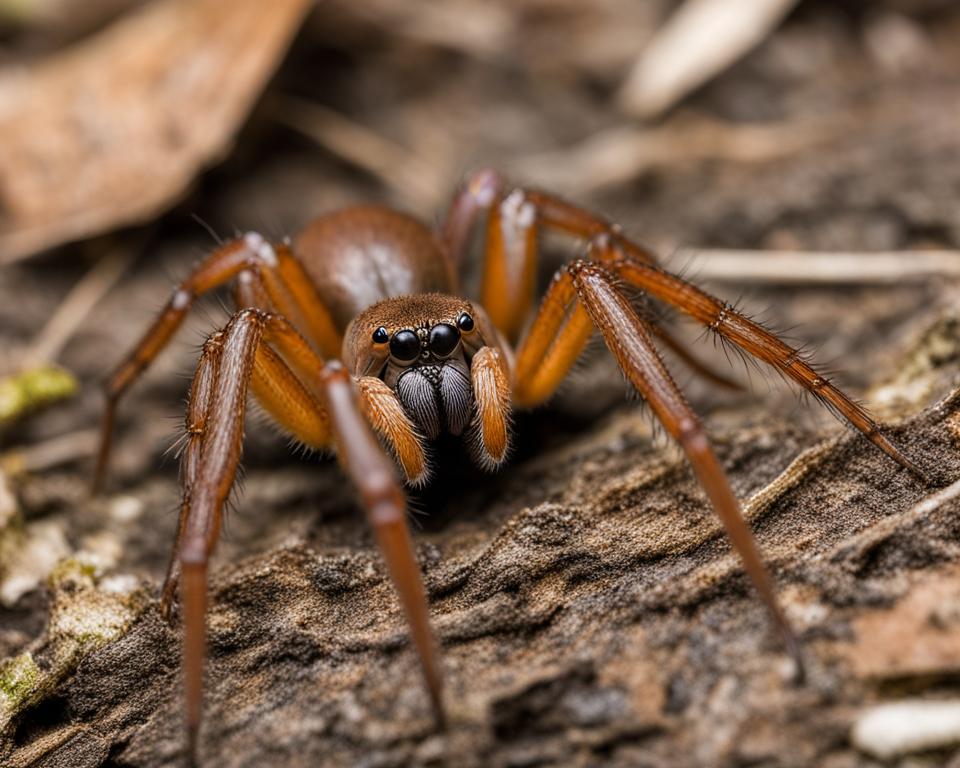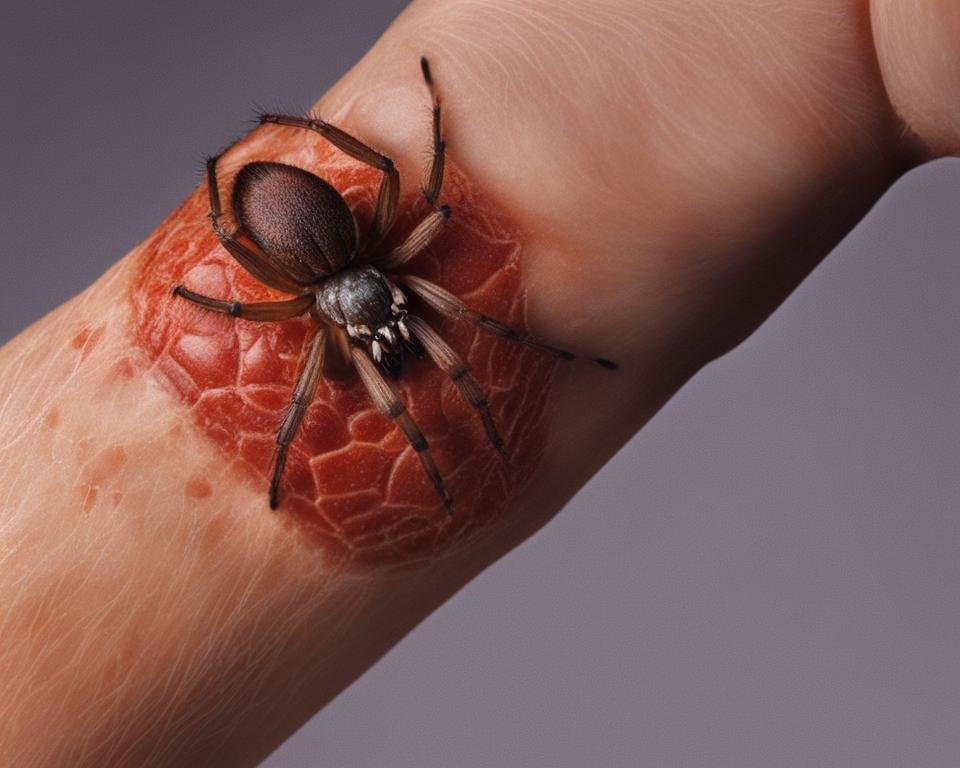Spiders are fascinating creatures that play an essential role in our ecosystem. However, some species can be harmful to humans, such as the ground spider and brown recluse. Knowing how to differentiate between these two types of spiders can help you protect yourself and your loved ones.
Key Takeaways:
- Ground spiders and brown recluse spiders can both be dangerous to humans.
- Understanding the differences in their physical appearance and behavior is crucial.
- Knowing their preferred habitats can help you avoid potential encounters.
- Familiarizing yourself with the symptoms of their bites is essential for taking appropriate action.
Ground Spider Identification
Ground spiders are widespread arachnids that belong to the Gnaphosidae family. They are known for their small-to-medium size and their capability to jump quickly on their prey.
Their color varies, but most ground spiders are black, dark brown, or grey, with some species featuring stripes or spots on their bodies. They have two main body parts, a cephalothorax, and an abdomen, and eight legs. Also, ground spiders possess eight eyes, arranged in two rows of four, and they have excellent vision.
To differentiate ground spiders from the brown recluse spider, it’s important to pay attention to the spider’s markings and behavior. Ground spiders are typically non-aggressive and won’t bite humans unless they feel threatened. They are also highly mobile and can often be seen running along the ground, while brown recluse spiders are slower and prefer hiding in dark places such as basements, attics, or closets.
Note: Be cautious when trying to identify a spider, as some species can be hard to differentiate and their bites can be dangerous.
Brown Recluse Identification
To properly identify a brown recluse spider, it’s essential to know its key features. Brown recluse spiders are typically light to dark brown in color and have a violin-shaped marking on their bodies, with the neck of the violin pointing towards the abdomen. They have six equal sized eyes arranged in three pairs and their legs are uniformly covered in fine hairs.
Young brown recluse spiders look similar to adults, but lack the violin-shaped marking and can have a more yellowish hue. Females are larger than males, with a body length ranging from 6 to 20 millimeters.
It’s important to note that other spider species can be mistaken for brown recluse spiders, so it’s crucial to be able to differentiate them by their unique characteristics. To ensure you can identify a brown recluse spider accurately, it’s recommended to reference credible sources for photographs and descriptions.
Ground Spider Habitat
Ground spiders are found in a variety of habitats, ranging from forests to grasslands to gardens. They tend to prefer areas with dense vegetation, where they can easily hunt for prey and hide from predators. In particular, they like to dwell in leaf litter, under rocks and logs, and among grasses and shrubs. Depending on the species, ground spiders may also be found in wetlands, deserts, and even urban environments.
The Trachelas tranquillus species of ground spider often inhabits the bark of dead trees and fallen logs, whereas the Lycosa rabida species can be found in open grassy areas.
Brown Recluse Habitat
Brown recluse spiders are commonly found in warm, dry environments. They typically seek shelter in secluded locations such as undisturbed attics, basements, closets, and storage areas.
These spiders can also be found outdoors in woodpiles, rock piles, and underneath outdoor furniture. They tend to favor areas with minimal human activity where they can hunt for prey undisturbed.

To protect yourself from brown recluse spiders, it’s essential to be aware of their preferred habitats. Keeping your home clean, clutter-free, and dry can help deter these spiders from entering. Regularly inspecting storage areas and outdoor spaces can also prevent potential encounters.
Ground Spider Bite
If you’ve been bitten by a ground spider, it’s important to identify the symptoms to determine if it was a ground spider bite. These spiders are not aggressive and usually only bite in self-defense. The bite may cause a sharp pain and leave two puncture marks on the skin.
While most ground spider bites aren’t dangerous, some people may experience mild to moderate symptoms, including:
- Redness and swelling at the bite site
- Mild to severe pain
- Itching
- Nausea and vomiting
If you experience any of these symptoms after a spider bite, seek medical attention immediately. It’s important to note that some symptoms, such as fever, chills, or muscle cramps, may indicate a more serious condition and require prompt medical attention.
“If you’ve been bitten by a ground spider, identifying the symptoms is the first step to determining the severity of the bite.”
Brown Recluse Bite
Brown recluse spiders are venomous, and their bites can cause serious symptoms and health problems. If you suspect that you have been bitten by a brown recluse spider, seek medical attention immediately.
Bite Symptoms
The symptoms of a brown recluse spider bite can vary depending on the individual, but typically include:
- Red or purple bruising around the bite
- Intense pain or burning sensation at the site of the bite
-
Development of a blister, which later opens and turns into an ulcer, leaving a deep, crater-like wound

- Fever and chills
- Nausea
- Joint pain or stiffness
In rare cases, brown recluse spider bites can result in systemic reactions, such as anemia or blood clotting abnormalities, which can be life-threatening.
Treatment
Immediate medical treatment is essential for a brown recluse spider bite. Treatment typically involves:
- Cleaning and dressing the wound to prevent infection
- Administering pain medication
- Applying a tetanus shot if the patient has not received one in the last ten years
- Prescribing antibiotics to prevent infection
- Providing anti-venom therapy in severe cases
Brown recluse spider bites can have serious consequences, so it’s essential to take precautions to avoid encounters with these spiders. Be sure to keep your homes and surroundings clean and free of clutter, and wear protective clothing when working in potentially infested areas.
Conclusion
Now that you have a better understanding of the differences between ground spiders and brown recluse spiders, you can take steps to protect yourself. One of the most important things to be aware of is the symptoms of their bites. Ground spider bites typically result in mild irritation and discomfort, but brown recluse bites can be much more serious and require medical attention.
If you experience the following symptoms after a spider bite, seek medical attention immediately:
- Severe pain
- Redness and swelling around the bite
- Blistering or ulceration
- Fever or chills
- Muscle aches or cramps
Remember, prevention is key. Check your shoes and clothing before putting them on, wear protective clothing when venturing into spider habitats, and keep your home clean and clutter-free to avoid spider infestations. By staying informed and taking precautions, you can minimize your risk of encountering dangerous spiders and their bites.
FAQ
What are the key differences between ground spiders and brown recluse spiders?
Ground spiders and brown recluse spiders have several distinguishing characteristics. Ground spiders have a more diverse range of appearances, while brown recluse spiders are typically light to dark brown with a violin-shaped marking on their cephalothorax. Brown recluse spiders are also known for their venomous bite, whereas ground spiders are generally harmless to humans.
How can I identify a ground spider?
Ground spiders are typically small to medium-sized, ranging in color from brown and gray to black. They have long legs and two prominent spinnerets at the end of their abdomen. Ground spiders are often found outdoors in burrows or under logs and rocks.
What are the identifying features of a brown recluse spider?
Brown recluse spiders are light to dark brown in color and have a distinct violin-shaped marking on their cephalothorax. They have six eyes arranged in pairs, unlike most spiders which have eight eyes. Brown recluse spiders also have long, slender legs.
Where can I find ground spiders?
Ground spiders prefer habitats such as grassy areas, gardens, and forests. They can often be found in burrows dug in the ground or under rocks, logs, and leaf litter.
What are the typical habitats of brown recluse spiders?
Brown recluse spiders are commonly found in storage areas, basements, attics, and closets. They prefer dark, quiet environments and can be found hiding in boxes, clothing, or other undisturbed areas.
What are the characteristics of a ground spider bite?
Ground spiders are generally harmless to humans and their bites are usually painless. The bite may cause minor swelling, redness, or itchiness, similar to a mosquito bite. These symptoms typically subside within a few days.
What are the symptoms of a brown recluse spider bite?
A brown recluse spider bite may initially go unnoticed or result in mild, localized pain. Within a few hours to days, a reddened area may develop, followed by a blister or ulcer. In some cases, the bite may lead to necrotic tissue, causing a deep, slow-healing wound. If you suspect a brown recluse spider bite, seek medical attention immediately.

